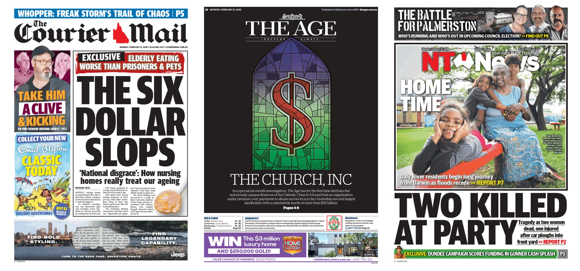
Laughing all the way to the pulpit
The Catholic Church has been found to be one of the largest non-government property owners in Australia, and the largest in Victoria, in new figures demonstrating a gross undervaluation of property assets made to major inquiries into child sexual abuse.
In their six-month investigation “Catholic Inc: What the Church is really worth“, The Age reports that the Church is worth over $30 billion in Australia and over $9 billion in Victoria, making it much wealthier than selective estimates it provided to the the Royal Commission into Institutional Responses to Child Sexual Abuse.
The figures were extrapolated from Victorian council valuation data and existing non-property assets such as Catholic Church Insurance, the church’s own internal banks, and investments in superannuation and telecommunications.
The figures also highlight the disparity between the Church’s coffers and its decades-long bid to minimise compensation payments to abuse survivors (estimated at $45,800 on average and $68.7 million in total), tax exemptions, and billions of dollars in government funding to run school services.
Historically, the Church has been protective in listing information regarding its wealth: Archbishop Denis Hart and executive director Francis Moore failed to provide details about church assets requested by the 2013 Victorian parliamentary inquiry into child abuse, while the Melbourne archdiocese provided a report valuing its properties at just $109 million when questioned again by the royal commission in 2014.
Maintaining the Gap
Australian government initiatives designed to Close The Gap between Indigenous and non-Indigenous Australians exceeded $130.2 billion over the eight years to 2016, in a price tag that, when compared to the programs’ low success rates, raises questions over government effectiveness.
According to analysis of government spending data by The Australian ($), $24.8 billion has been spent on programs exclusively available to Indigenous Australians and attempts to halve the gap in workforce participation, a 2008 target set under former prime minister Kevin Rudd that is unlikely to be met in time, have cost $45 billion over the eight years from 2009.
The figures come as Prime Minister Malcolm Turnbull prepares to deliver the 10th annual Closing the Gap report in parliament today, showing that only three of the seven targets are on track to be met: national childhood mortality, early childhood education and year 12 attainment. The largely unsuccessful process has been criticised by the Close the Gap Campaign Steering Committee for its inadequate input from Indigenous communities, lack of planning, and Abbott-era funding cuts and bureaucracy.
“We want to see premiers, chief ministers, health and indigenous affairs ministers in every jurisdiction providing regular, public accountability on their efforts to address the inequality gaps in their state or territory — no more finger-pointing between governments,” Aboriginal and Torres Strait Islander Social Justice Commissioner June Oscar told Turnbull when delivering the report, which highlights a widening life expectancy gap for Indigenous Australians, last week.
Indigenous Affairs Minister Nigel Scullion has said today’s report will deliver the best results since 2011, with two of the seven targets, national childhood mortality and early childhood education, back on track, up from just year 12 attainment last year. However, Turnbull currently faces sustained criticism from Indigenous leaders over his refusal to engage with the Uluru Statement.
READ ALL ABOUT IT
‘She’s a brilliant student’: family of alleged IS stabber shocked
Australia’s solar power boom could almost double capacity in a year, analysts say
Barnaby Joyce’s hold on power at risk over affair: Nats ($)
Labor promises stolen generations compensation fund
Fairfax confirms HR complaint over culture ($)
Russian passenger plane crashes outside Moscow, killing 71
WHAT’S ON TODAY
Perth: After voting yes to an EBA on Friday, workers from the Griffin Coal mine will protest outside a Fair Work Commission hearing between the AMWU and Griffin Coal.
Canberra: Closing the Gap report and speeches in federal parliament from Malcolm Turnbull and Bill Shorten.
Canberra: Kevin Rudd to deliver press club address on 10th Anniversary of the National Apology to Indigenous Australians.
Melbourne: First public hearing for the Royal Commission into Misconduct into the Banking, Superannuation and Financial Services Industry.
Brisbane: Crime Stopper Queensland will release annual crime data report.
Australia: Start of Smart Eating Week, a series of events run by Accredited Practising Dietitians.
THE COMMENTARIAT
Can ABC be trusted to hold the government to account? — Andrew Fowler (The Guardian): “In an organisation already jittery following the assault from Tony Abbott that it was un-Australian in the way it reported the refugee crisis and Australia’s role in supporting US spying on the region, Morris’s statement sent a clear message: there will be no more investigative journalism at the ABC of national security matters which are not officially sanctioned by the government.”
Politics before workers’ wellbeing for Shorten — Mathias Cormann (The Australian $): “Our economic mission is to secure more jobs and higher wages so families around Australia today and in the future have the best possible opportunity to get ahead. Jobs and higher wages don’t grow on trees. They are created and paid for by successful, profitable businesses.”
CRIKEY QUICKIE: THE BEST OF FRIDAY
How Closing The Gap fell apart — Bernard Keane: “There’s plenty of blame to go around for the failure of the Closing The Gap effort over the last decades. It’s been the victim of funding cuts, Canberra’s insular mentality and our federal structure that makes dealing with Indigenous issues an exercise in almost Kafkaesque bureaucratic complexity.”
How the Seven Network is failing the AFLW — Kylie Maslen: “On Wednesday the AFL took the unprecedented step of contacting all eight AFLW coaches to issue directives as to how they should be running play. Phone calls were followed up by a memo, which was then leaked to the media. The AFL’s concern is that the style of play being fielded in the AFLW is too defensive, too congested, and not conducive to free-flowing football, which is seen as the most exciting form of the game for audiences.”
Department of Social Services tried to hide data breach from affected employees — John Power: “The Department of Social Services initially decided not to inform employees of a major privacy breach last year that exposed the personal data of 8,500 current and former staffers, reasoning that it would cause unnecessary concern.”
HOLD THE FRONT PAGE









Crikey is committed to hosting lively discussions. Help us keep the conversation useful, interesting and welcoming. We aim to publish comments quickly in the interest of promoting robust conversation, but we’re a small team and we deploy filters to protect against legal risk. Occasionally your comment may be held up while we review, but we’re working as fast as we can to keep the conversation rolling.
The Crikey comment section is members-only content. Please subscribe to leave a comment.
The Crikey comment section is members-only content. Please login to leave a comment.